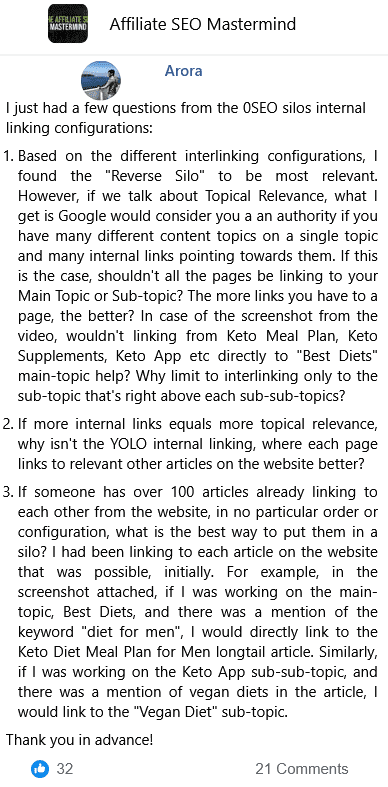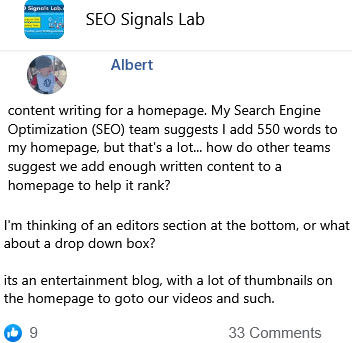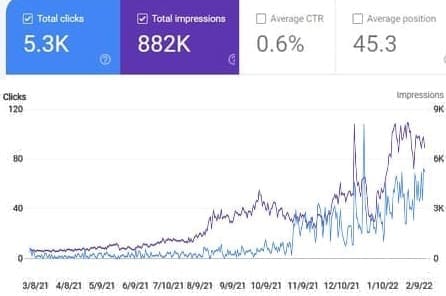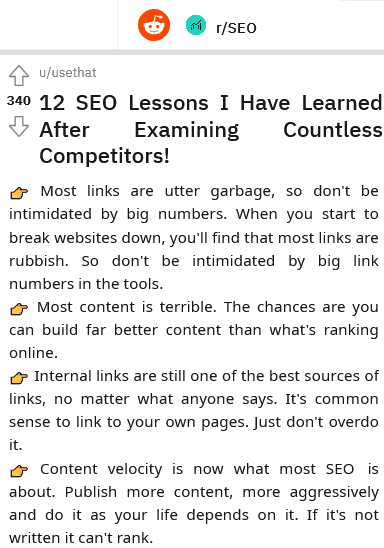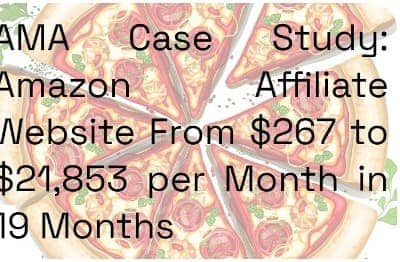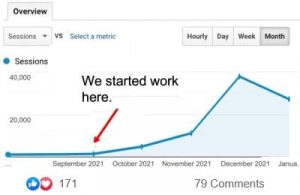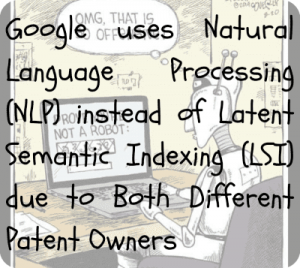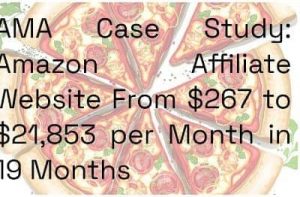Arora
I just had a few questions from the SEO silos internal linking configurations:
Based on the different interlinking configurations, I found the "Reverse Silo" to be most relevant. However, if we talk about Topical Relevance, what I get is Google would consider you a an authority if you have many different content topics on a single topic and many internal links pointing towards them. If this is the case, shouldn't all the pages be linking to your Main Topic or Sub-topic? The more links you have to a page, the better? In case of the screenshot from the video, wouldn't linking from Keto Meal Plan, Keto Supplements, Keto App etc directly to "Best Diets" main-topic help? Why limit to interlinking only to the sub-topic that's right above each sub-sub-topics?
If more internal links equals more topical relevance, why isn't the YOLO internal linking, where each page links to relevant other articles on the website better?
If someone has over 100 articles already linking to each other from the website, in no particular order or configuration, what is the best way to put them in a silo? I had been linking to each article on the website that was possible, initially. For example, in the screenshot attached, if I was working on the main-topic, Best Diets, and there was a mention of the keyword "diet for men", I would directly link to the Keto Diet Meal Plan for Men longtail article. Similarly, if I was working on the Keto App sub-sub-topic, and there was a mention of vegan diets in the article, I would link to the "Vegan Diet" sub-topic.
Thank you in advance!
31 👍🏽32
21 💬🗨
I just had a few questions from the SEO silos internal linking configurations:
Based on the different interlinking configurations, I found the "Reverse Silo" to be most relevant. However, if we talk about Topical Relevance, what I get is Google would consider you a an authority if you have many different content topics on a single topic and many internal links pointing towards them. If this is the case, shouldn't all the pages be linking to your Main Topic or Sub-topic? The more links you have to a page, the better? In case of the screenshot from the video, wouldn't linking from Keto Meal Plan, Keto Supplements, Keto App etc directly to "Best Diets" main-topic help? Why limit to interlinking only to the sub-topic that's right above each sub-sub-topics?
If more internal links equals more topical relevance, why isn't the YOLO internal linking, where each page links to relevant other articles on the website better?
If someone has over 100 articles already linking to each other from the website, in no particular order or configuration, what is the best way to put them in a silo? I had been linking to each article on the website that was possible, initially. For example, in the screenshot attached, if I was working on the main-topic, Best Diets, and there was a mention of the keyword "diet for men", I would directly link to the Keto Diet Meal Plan for Men longtail article. Similarly, if I was working on the Keto App sub-sub-topic, and there was a mention of vegan diets in the article, I would link to the "Vegan Diet" sub-topic.
Thank you in advance!
31 👍🏽32
21 💬🗨
📰👈
Mew
I'd just like to chime in and let people know that silos work from the bottom up, not the top down.
Google documentation calls it "Agglomerative Hierarchical Clustering", in which search engines learn your content's pieces to form a complete understanding of its entire focus.
They specifically modeled this after how humans learn. For example, you can't type sentences unless you learn letters, than words. And in the same sense Google learns all of your content before it has an understand of what your blog or website is.
You can read more here!
To answer your questions:
1. Your bottom level phrases/low competition keywords you have gained authority over should link up to your next level of phrases and medium competition, and then medium competition up to seed level money pages. This is how authority is built. There are algorithms that use retroactive data to understand how your previous pages did, and H.E.A.R.T metrics (another Google patent), to give weight to other pages that lead up in your silo. If you send link equity everywhere (all articles) it will multiply at an unknown rate that could be ~ instead of +, rather than in the precise direction you want it to, from the standpoint of your vectors as a 3d model.
2. More links don't necessarily equal topical relevance, if Google doesn't find the topic relevant to the adjacent, or higher topic. It's best to look at how Google is already grouping keywords, semantic phrasing, and micro silos within your primary silos. This is always better than guessing, and can be done by either examining the interlink profiles of the top 3 positions in the Search Engine Result Page (SERP) or looking at keywords with unpacking modifiers and grouping them into clusters based on SERP overlap.
3. The above image is very rudimentary at best. Within Keto diet you have 1000 sub topics, all the same as paleo and vegan, which can link up to your seed keywords/money pages. It varies from topic to topic as some topics have tons of overlap, regardless of semantic differences, and should be thought of on a case by case scenario. If I was in your position I would being looking at how your articles fall under topics as sub topics, and interlinking them together based on logical identification. For example if you have a "Keto Plan for Woman over 50" and "Keto Plan For Male Body Builders", those would fall under the respective silos for each gender, but ultimately depends on how many total articles there are. I would then link together other blogs or articles that have similar topics to those above, and so that everything flows in an upward direction.
I hope all that makes sense

🔗🏹
💟20
I'd just like to chime in and let people know that silos work from the bottom up, not the top down.
Google documentation calls it "Agglomerative Hierarchical Clustering", in which search engines learn your content's pieces to form a complete understanding of its entire focus.
They specifically modeled this after how humans learn. For example, you can't type sentences unless you learn letters, than words. And in the same sense Google learns all of your content before it has an understand of what your blog or website is.
You can read more here!
https://scholar.google.com/scholar?q=agglomerative%20hierarchical%20clustering&hl=en&as_sdt=0&as_vis=1&oi=scholartTo answer your questions:
1. Your bottom level phrases/low competition keywords you have gained authority over should link up to your next level of phrases and medium competition, and then medium competition up to seed level money pages. This is how authority is built. There are algorithms that use retroactive data to understand how your previous pages did, and H.E.A.R.T metrics (another Google patent), to give weight to other pages that lead up in your silo. If you send link equity everywhere (all articles) it will multiply at an unknown rate that could be ~ instead of +, rather than in the precise direction you want it to, from the standpoint of your vectors as a 3d model.
2. More links don't necessarily equal topical relevance, if Google doesn't find the topic relevant to the adjacent, or higher topic. It's best to look at how Google is already grouping keywords, semantic phrasing, and micro silos within your primary silos. This is always better than guessing, and can be done by either examining the interlink profiles of the top 3 positions in the Search Engine Result Page (SERP) or looking at keywords with unpacking modifiers and grouping them into clusters based on SERP overlap.
3. The above image is very rudimentary at best. Within Keto diet you have 1000 sub topics, all the same as paleo and vegan, which can link up to your seed keywords/money pages. It varies from topic to topic as some topics have tons of overlap, regardless of semantic differences, and should be thought of on a case by case scenario. If I was in your position I would being looking at how your articles fall under topics as sub topics, and interlinking them together based on logical identification. For example if you have a "Keto Plan for Woman over 50" and "Keto Plan For Male Body Builders", those would fall under the respective silos for each gender, but ultimately depends on how many total articles there are. I would then link together other blogs or articles that have similar topics to those above, and so that everything flows in an upward direction.
I hope all that makes sense
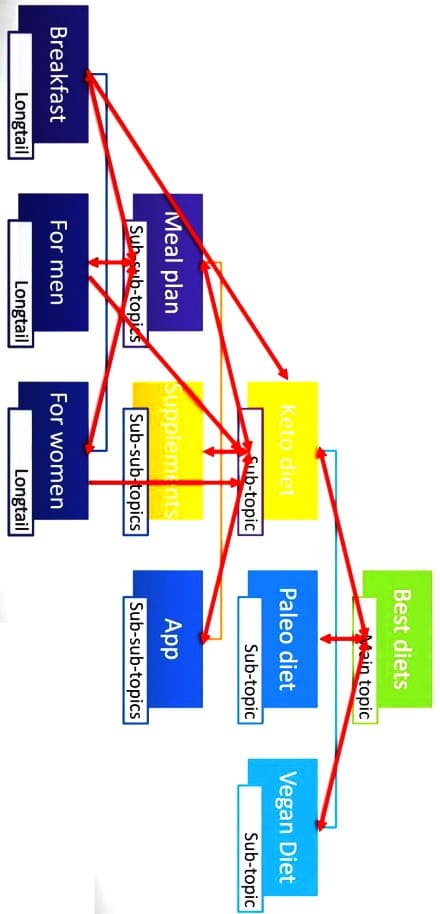
💟20
Drew » Mew
Just to clarify … does that mean that you ONLY link up, and not in both directions?
Mew » Drew
In essence, it means that unless you have already built your site out, with all auxiliary articles, linking down wouldn't make sense, unless you're trying to rank an article below your current tier.
Affiliate sites are usually built from low competition keywords to high, also known as a the pyramid theme method.
But yes, if all pages are built out, than linking down for a new page, would make sense 🙂
Kosik
Mew Well, from my perspective linking down make more sense. From general to specific.
maybe I don't catch it. From where do you link to your down pyramid? Only blog pagination? How often it would be crawled?
If you build from down… You have to create internalinking to them.I mean – from home page, menu or whatever. Homepage mostly distribute highest PR. Basically – these are the most important places so I don't think you want to link from homepage to your totally down, super long tail keyword page as it's easy to rank.
Pets>Dogs>husky>best food for husky
Best food for husky>Husky>Dogs>Pets
The first one make more logical sense, especially from human perspective. At least for me 😃 Also I often link back to the highest URL.
Even If we can't rank for such generic keywords it still make sens from semantic perspective and logical structure.
Link juice – the top level page in cluster can be pilar page. Like the ultimage guide about keto diet. So basically you can do link-building for this URL. In your pilar each heading = differnt sub topic. Then you can link out to subtopics if you create a separeted URl for them. And then from this subtopics again the same to sub-sub topics.
Arora ✍️ » Mew
Thanks for this, it's very informative. From what I get is I need to first be able to categorize each of my article into levels, and then interlink from top to bottom. At this point, I've already lost most of my traffic, so this would be a great experiment.
Just to clarify … does that mean that you ONLY link up, and not in both directions?
Mew » Drew
In essence, it means that unless you have already built your site out, with all auxiliary articles, linking down wouldn't make sense, unless you're trying to rank an article below your current tier.
Affiliate sites are usually built from low competition keywords to high, also known as a the pyramid theme method.
But yes, if all pages are built out, than linking down for a new page, would make sense 🙂
Kosik
Mew Well, from my perspective linking down make more sense. From general to specific.
maybe I don't catch it. From where do you link to your down pyramid? Only blog pagination? How often it would be crawled?
If you build from down… You have to create internalinking to them.I mean – from home page, menu or whatever. Homepage mostly distribute highest PR. Basically – these are the most important places so I don't think you want to link from homepage to your totally down, super long tail keyword page as it's easy to rank.
Pets>Dogs>husky>best food for husky
Best food for husky>Husky>Dogs>Pets
The first one make more logical sense, especially from human perspective. At least for me 😃 Also I often link back to the highest URL.
Even If we can't rank for such generic keywords it still make sens from semantic perspective and logical structure.
Link juice – the top level page in cluster can be pilar page. Like the ultimage guide about keto diet. So basically you can do link-building for this URL. In your pilar each heading = differnt sub topic. Then you can link out to subtopics if you create a separeted URl for them. And then from this subtopics again the same to sub-sub topics.
Arora ✍️ » Mew
Thanks for this, it's very informative. From what I get is I need to first be able to categorize each of my article into levels, and then interlink from top to bottom. At this point, I've already lost most of my traffic, so this would be a great experiment.
📰👈
Each Competitor Outranks My Client with More Number of Internal Links or Silos
On-Page SEO Anchor Internal Link Optimation: Never Let Visitors Leave the Related Posts They are On!
Two Things Worked in SEO: Silo, Backlink
Prioritized Silo or Interlinking Case Study: 0 to 30K Visits a Month in 6 Months
Ammon: Google don’t Care about Silos, or Pages Only Linking to Other Pages on the Same Topic, Same Website
Embed this to your blogs! Then visit Ke-1.com anytime!
